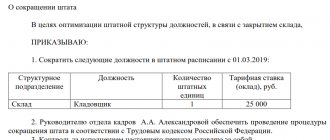In what case can you challenge a layoff at work?
In case of violation of at least one rule established for this procedure by the Labor Code, or a ban on layoffs of a certain category of persons. It is advisable with the condition that such a violation led to the infringement of an important employee’s right, for example, to prohibit discrimination in labor.
General rules for the reduction of personnel and personnel
- The company management must notify the primary trade union (if this body has been created) in writing two months in advance of the planned reduction. If there are massive layoffs, three months in advance.
- An employee who has membership in a local trade union can be laid off only taking into account the opinion of this body.
- Each employee must receive a personal written notice of this against signature two months before dismissal. When working under a contract for a period of up to two months - three days, and for seasonal work - seven days. Dismissal before the designated time limits is possible only by agreement with the subordinate and with mandatory payment for the remaining working time before the expiration of the initial notice of layoff.
- Before a final decision is made, the employee must be offered all suitable vacancies, even those that require a lower level of education and with a lower salary.
- A specialist with higher labor productivity (that is, the efficiency of performing the assigned function) and qualifications (level of education, professional training, business qualities) has a legal advantage over other employees to be retained at work. As the totality of court decisions made in favor of workers shows, a comparison of these two indicators among laid-off personnel must be carried out.
- With equal indicators of efficiency and professionalism, the privilege to avoid layoffs remains with the employee: providing for two or more family members (dependents); the sole breadwinner of the family; injured or contracted an occupational disease at work; disabled war veteran; directed by the employer, studies on the job.
- Additional rules on benefits and compensation during layoffs, introduced into the organization by collective agreement, are mandatory.
Preemptive right
The first of these violations is the lack of division by priority right. Article 179 of the Labor Code determines that in case of staff reduction, the priority right to remain at work is given to employees with the highest labor productivity and qualifications.
With equal productivity and work experience, preference is given to: family workers - if there are two or more dependents (disabled family members who are fully supported by the employee or who receive assistance from him, which is their constant and main source of livelihood); persons in whose family there are no other independent workers; employees who received a work injury or occupational disease while working for the company; disabled people of the Great Patriotic War and disabled people fighting in defense of the Fatherland; employees who improve their qualifications in the direction of the employer without interruption from work.
To avoid such mistakes when carrying out the reduction procedure, it is recommended to clearly define the circle of employees who fall under the list of persons who have a preferential right to retain their position.
I note that this article does not introduce a ban on layoffs of employees of the listed categories. It only establishes a pre-emptive right!
For example, when two identical positions are laid off, the employee who falls into the specified categories will have the priority right to remain. If both employees are not such persons, then priority rights are given to employees with higher labor productivity and qualifications. It is quite simple to prevent such a violation - you just need to remember that such an article exists in the Labor Code, and when determining the circle of persons subject to reduction, be guided by its provisions.
note
It is recommended to clearly define the circle of employees who fall under the list of persons who have a preferential right to retain their position. I note that the Labor Code of the Russian Federation does not introduce a ban on reductions, it only establishes a pre-emptive right.
Who does not have the right to be laid off at work?
In the reduction procedure, the law protects the following categories of workers:
- disabled on sick leave (but when the certificate of incapacity for work expires, “immunity” disappears);
- those on maternity leave and pregnant women;
- currently using any type of leave (but can be fired at the end of the leave);
- women with children under three years of age;
- mothers of disabled children or children under 14 years of age in the absence of fathers in the family, as well as their guardians and trustees;
- parents who provide only with their salary a disabled child under 18 years of age, children under three years of age, or who have more than three children under 14 years of age in the family.
How much money must be paid upon redundancy?
Upon dismissal, a redundant employee receives from the employer monetary compensation (known as severance pay) in the amount of the average monthly salary for the next two months, and if it is impossible to find a job, for the next third. The decision to pay for the third month at the expense of the employer is made by the employment service, provided that within two weeks after dismissal, the employee officially became a job seeker at the labor exchange.
The rule has exceptions: the amount of benefits for a seasonal worker is the average salary for two weeks, and specialists whose employment contract period is less than two months are not paid at all.
Also, following the general rule regarding settlements upon dismissal, the employer pays compensation for vacation that the employee did not have time to take.
Unemployment benefit
Citizens who have lost their jobs and applied to the labor exchange will not receive benefits at the expense of the state immediately. The fact is that for the first two months after layoffs (in exceptional cases three months), they still receive compensation at the expense of the employer in the amount of at least the average monthly salary. The assignment of unemployment benefits will be carried out after their termination.
Its size (calculated from average monthly earnings) is:
- 75% for the first three months;
- 60% subsequent four months;
- 45% remaining time.
I see that I was fired with violations. What to do if an employee is illegally laid off?
The first option is a complaint to the State Labor Inspectorate.
The task of this body is to monitor violations of labor rights, including those reported by the workers themselves. If a violation is found, the inspection will order the organization to eliminate it, in our case, to reinstate the illegally dismissed person.
Massive complaints from former employees about illegal layoffs from one employer will be effective. In addition, illegal dismissals at large or well-known enterprises may well cause a public outcry, and then the inspectorate will treat the complaint more carefully.
But, unfortunately, the requirements are poorly implemented in practice.
The second option is to go to court.
Every dismissed employee has the right to ask for judicial protection, the subject of which may be demands for reinstatement at work or changing an article in the work book to an article “at his own request.”
The period for going to court to challenge a reduction is short - a month, counting from the date of delivery of the dismissal order. Therefore, there is no need to delay the decision to sue. The deadline for collecting unpaid compensation is more democratic - a year, counting from the same date. However, to be fair, we note that the court can restore both periods at the request of the employee if there were individual good reasons: serious illness, departure, etc.
Undoubtedly, litigation on a claim for illegal layoffs is often a lengthy, uncomfortable, and also expensive matter - you will have to pay for the services of a lawyer.
Trdat Group specialists almost completely neutralize the first two shortcomings: documents are prepared quickly, court hearings are used effectively, and all significant legal actions in the process are carried out by proxy from the client without his participation.
As for monetary costs, employees are exempt from paying state fees in courts with employers. And the costs of lawyers, if the case is won, will be recovered from the defendant in almost the full amount - confirmed by judicial practice.
The RF Armed Forces clarified which dismissal “due to reduction” is considered illegal
Photo: piqsels.com It is possible to dismiss an employee due to staff reduction only if all available vacant positions in the area that correspond to his qualifications are offered. This is stated in the corresponding ruling of the Supreme Court of the Russian Federation.
A resident of the Krasnoyarsk Territory, Anatoly Dobryakov, filed a complaint with the RF Armed Forces. In 1986, he worked in various positions at a mining and chemical plant, most recently as an electric and gas welder. On October 9, 2021, he was notified of his impending dismissal due to a reduction in his position. On December 28, the employment contract with Dobryakov was terminated and he was fired.
The man considered the actions of his former employer illegal. According to him, for several months the management did not offer him another available job (both a vacant position corresponding to Dobryakov’s qualifications and a lower one). At the same time, the employer had vacant positions that a man could fill, taking into account his education, qualifications, work experience and health status.
Dobryakov demanded compensation for his average earnings during forced absence in the amount of 63.2 thousand rubles, compensation for moral damage in the amount of 100 thousand rubles, as well as expenses for the services of a representative and a notary. However, the court of first instance rejected the claim, and higher courts supported this position. They stated that Dobryakov was properly notified of the upcoming layoff, and the employer did not have any vacant positions corresponding to his qualifications.
The courts referred to the fact that the current legislation does not regulate the procedure for offering vacant positions to employees, and the right to decide which of the laid-off employees to offer to fill the vacant position belongs to the employer. The Supreme Court found this interpretation of the legislation incorrect.
The RF Supreme Court sent the case for review.
The Judicial Collegium of the Supreme Court referred to the resolution of the Plenum of the Supreme Court of the Russian Federation dated March 17, 2004, which provided clarifications on the procedure for dismissal in connection with staff reduction. Thus, the Supreme Court ruled that in accordance with Part 3 of Art. 81 of the Labor Code of the Russian Federation, such a reduction is allowed if it is impossible to transfer the employee with his written consent to another job available to the employer, which he can perform taking into account his state of health. This could be a lower-ranking position or a lower-paid job.
“Courts should keep in mind that the employer is obliged to offer the employee all qualified vacancies available in the local area. When deciding on transferring an employee to another job, it is also necessary to take into account the employee’s real ability to perform the work offered to him, taking into account his education, qualifications, and work experience,” the Supreme Court emphasized.
An employer may terminate an employment contract with an employee under clause 2, part 1, art. 81 of the Labor Code of the Russian Federation (staff reduction), only if he offered the employee all available vacant positions in the area that correspond to his qualifications. Failure to fulfill such an obligation in the event of a dispute about the legality of dismissal entails its recognition as illegal.
“The employer’s obligation to offer the employee vacant positions that meet the above requirements means that the employer must offer the employee all vacant positions available in the employer’s staffing table, both on the day the employee was notified of the upcoming dismissal due to a reduction in the number or staff of employees, and those created during the period time from the beginning of the employer’s organizational and staffing measures (warning the employee about dismissal) until the day of the employee’s dismissal, inclusive,” the Supreme Court concluded.
Our assistance to illegally laid off workers
We are ready to provide a range of the following services:
- During a personal consultation, we will explain in an accessible and comprehensive manner about all the rights of an employee when being laid off at work.
- We will analyze the specific situation of our client’s dismissal and find the optimal solution on how to challenge the layoff at work.
- We will organize negotiations with your former management with the aim of pre-trial peaceful settlement of the dispute (solely at the request of the client).
- We will independently collect documents to prove our position in the dispute, including talking with future witnesses in advance, if any are necessary.
- We will write a statement of claim to the court, create a complete package of documents and submit it.
- We will attend all court hearings for our client and make his personal participation in the case minimal.
- We will appeal the decision not in our favor.
- We will accompany the process of reinstatement in court after a layoff or change of entry in the work book.
- We will act as a representative of the client in interaction with the labor inspectorate.
We calculate the cost of services based on the complexity of the case and inform you at the first consultation.











